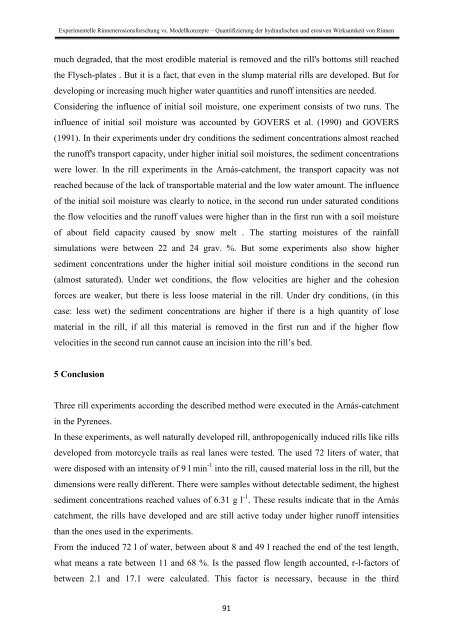Stefan Wirtz Vom Fachbereich VI (Geographie/Geowissenschaften ...
Stefan Wirtz Vom Fachbereich VI (Geographie/Geowissenschaften ...
Stefan Wirtz Vom Fachbereich VI (Geographie/Geowissenschaften ...
Create successful ePaper yourself
Turn your PDF publications into a flip-book with our unique Google optimized e-Paper software.
Experimentelle Rinnenerosionsforschung vs. Modellkonzepte – Quantifizierung der hydraulischen und erosiven Wirksamkeit von Rinnen<br />
much degraded, that the most erodible material is removed and the rill's bottoms still reached<br />
the Flysch-plates . But it is a fact, that even in the slump material rills are developed. But for<br />
developing or increasing much higher water quantities and runoff intensities are needed.<br />
Considering the influence of initial soil moisture, one experiment consists of two runs. The<br />
influence of initial soil moisture was accounted by GOVERS et al. (1990) and GOVERS<br />
(1991). In their experiments under dry conditions the sediment concentrations almost reached<br />
the runoff's transport capacity, under higher initial soil moistures, the sediment concentrations<br />
were lower. In the rill experiments in the Arnás-catchment, the transport capacity was not<br />
reached because of the lack of transportable material and the low water amount. The influence<br />
of the initial soil moisture was clearly to notice, in the second run under saturated conditions<br />
the flow velocities and the runoff values were higher than in the first run with a soil moisture<br />
of about field capacity caused by snow melt . The starting moistures of the rainfall<br />
simulations were between 22 and 24 grav. %. But some experiments also show higher<br />
sediment concentrations under the higher initial soil moisture conditions in the second run<br />
(almost saturated). Under wet conditions, the flow velocities are higher and the cohesion<br />
forces are weaker, but there is less loose material in the rill. Under dry conditions, (in this<br />
case: less wet) the sediment concentrations are higher if there is a high quantity of lose<br />
material in the rill, if all this material is removed in the first run and if the higher flow<br />
velocities in the second run cannot cause an incision into the rill’s bed.<br />
5 Conclusion<br />
Three rill experiments according the described method were executed in the Arnás-catchment<br />
in the Pyrenees.<br />
In these experiments, as well naturally developed rill, anthropogenically induced rills like rills<br />
developed from motorcycle trails as real lanes were tested. The used 72 liters of water, that<br />
were disposed with an intensity of 9 l min -1 into the rill, caused material loss in the rill, but the<br />
dimensions were really different. There were samples without detectable sediment, the highest<br />
sediment concentrations reached values of 6.31 g l -1 . These results indicate that in the Arnás<br />
catchment, the rills have developed and are still active today under higher runoff intensities<br />
than the ones used in the experiments.<br />
From the induced 72 l of water, between about 8 and 49 l reached the end of the test length,<br />
what means a rate between 11 and 68 %. Is the passed flow length accounted, r-l-factors of<br />
between 2.1 and 17.1 were calculated. This factor is necessary, because in the third<br />
91
















